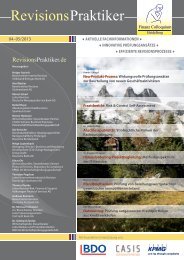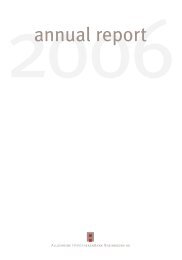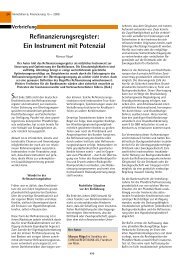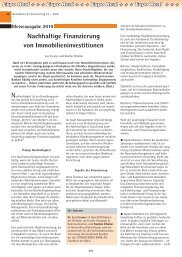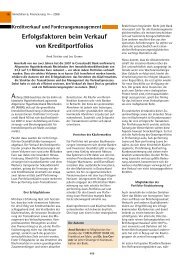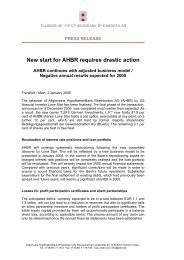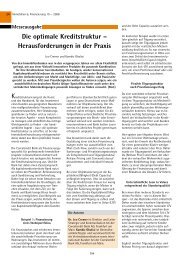COREALCREDIT BANK AG
COREALCREDIT BANK AG
COREALCREDIT BANK AG
You also want an ePaper? Increase the reach of your titles
YUMPU automatically turns print PDFs into web optimized ePapers that Google loves.
PFANDBRIEFE<br />
The following is a summary description of certain fundamental principles of the laws governing<br />
Pfandbriefe and Pfandbrief Banks, and therefore does not address all the complexities and details<br />
of such laws. Accordingly, the description is qualified in its entirety by reference to the applicable<br />
laws.<br />
Rules applicable to all Types of Pfandbriefe<br />
Pfandbriefe are standardised debt instruments issued by a Pfandbrief Bank. The quality and<br />
standards of Pfandbriefe are strictly governed by provisions of the Pfandbrief Act<br />
(Pfandbriefgesetz) and are subject to the supervision of the BaFin. Pfandbriefe generally are<br />
medium- to long-term bonds, typically with an original maturity of between two and ten years,<br />
which are secured or "covered" at all times by a pool of specified qualifying assets (Deckung), as<br />
described below (the "Cover Pool"). Pfandbriefe are recourse obligations of the issuing bank, and<br />
no separate vehicle is created for their issuance generally or for the issuance of any specific series<br />
of Pfandbriefe. Pfandbriefe may not be redeemed at the option of the holders prior to maturity.<br />
Pfandbriefe may be issued either as Mortgage Pfandbriefe, Public Sector Pfandbriefe, Ship<br />
Mortgage Pfandbriefe or Aircraft Pfandbriefe. The outstanding Pfandbriefe of any one of these<br />
types must be covered by a separate Cover Pool: a Cover Pool specifically for Mortgage<br />
Pfandbriefe, a Cover Pool specifically for Public Sector Pfandbriefe, a Cover Pool specifically for<br />
Ship Mortgage Pfandbriefe and a Cover Pool specifically for Aircraft Pfandbriefe. An independent<br />
trustee appointed by the BaFin has extensive duties in monitoring compliance of the Pfandbrief<br />
Bank with the provisions of the Pfandbrief Act (Pfandbriefgesetz). In particular, the trustee monitors<br />
the sufficiency of the cover assets and maintaines a register of the cover assets used to provide<br />
cover for each type of Pfandbriefe (the "Cover Register"). Any issue of Pfandbriefe must first be<br />
certified by the trustee.<br />
The coverage of all outstanding Pfandbriefe with respect to their principal and interest must at all<br />
times be ensured on the basis of their net present value (Barwert). The net present value of the<br />
assets contained in the Cover Pool must exceed the total amount of liabilities arising from the<br />
corresponding Pfandbriefe and derivatives by at least 2% (excess cover (Sichernde<br />
Überdeckung)).<br />
Such 2 per cent. excess cover must consist of highly liquid assets. Qualifying assets for such<br />
excess cover are: (i) certain debt instruments (e.g. notes) the debtor of which is the German<br />
Federal Government, a special fund (Sondervermögen) of the German Federal Government, a<br />
Federal State, the European Communities, another EU or EEA member state, the European<br />
Investment Bank, the World Bank, the Council of Europe Development Bank or the European<br />
Bank for Reconstruction and Development, or, if they fulfil certain rating criteria, Switzerland, the<br />
United States of America, Canada or Japan, (ii) notes guaranteed by one of the debtors set out<br />
under (i) above, and (iii) balances with the European Central Bank, any central bank of a EU<br />
member state or any other suitable credit institution located in one of the countries listed under<br />
(i) above if certain rating criteria are fulfilled.<br />
In addition, a daily comparison of the claims under the registered cover assets which become due<br />
and the liabilities becoming due under the outstanding Pfandbriefe and derivative transactions<br />
which are part of the cover pools, must be carried out for the following 180 days in order to ensure<br />
liquidity. The amount of all daily differences accrued up to this date must be calculated for each<br />
day. The highest negative amount calculated for the following 180 days must at all times be<br />
covered by the total amount of certain eligible cover assets. The aggregate principal amount of the<br />
cover assets contained in a cover pool must furthermore at all times be greater than or equal to<br />
168



